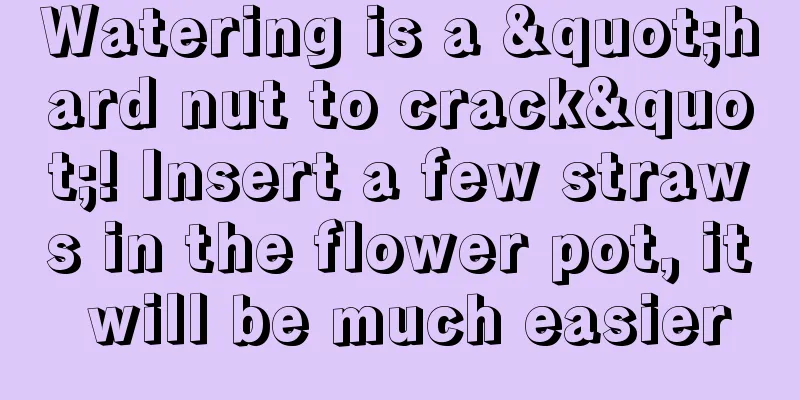Watering is a "hard nut to crack"! Insert a few straws in the flower pot, it will be much easier

|
In fact, every experienced flower-growing expert has evolved from a novice flower-growing expert. After growing flowers for a long time, they will have their own tips for watering. Today, Huahua will introduce several tips to you so that you don’t have to worry about watering problems from now on. 1. Insert a few straws into the flower potInserting straws into flower pots is not a common practice, but it is indeed very helpful to prevent waterlogging and root rot caused by overwatering. After the straw is inserted into the soil, it can increase the looseness of the soil, allow excess water to evaporate, and prevent the soil from becoming compacted. The specific method is to insert the pre-prepared long straw into the soil along the edge of the flower pot, preferably all the way to the bottom of the flower pot. The next step is to add coarse sand to the inserted straw. After pulling out the straw, a coarse sand column will be formed. In this way, when watering in the future, the previous water accumulation phenomenon will not occur, and the plant will grow more vigorously. 2. Use a bamboo stick to determine whether the plant has been wateredMany times we don't water the flowers correctly because we don't know when exactly we need to water them. The soil in the pots of most flowers should be in a relatively dry state when watering, but it is sometimes difficult to judge with the naked eye. At this time, we can use a small bamboo stick to help, so that we won't make mistakes. The method is to insert a bamboo stick into the soil. If it is moist when you pull it out, don't water it at this time. If it is relatively dry, you can water it a little. You can also insert a bamboo stick after watering, pull it out after a few days and check. If the color changes significantly, it means watering is needed. This little trick is very practical for novice flower lovers, and there is no need to worry about watering incorrectly. 3. Watering with a squeeze bottleAfter knowing when to water, the next step is to control the amount of water. Plants like succulents generally do not require a lot of water when watering. At this time, you can use a squeeze watering bottle to water it, so that you can control the amount of water and prevent water accumulation caused by excessive watering. The squeeze-type watering bottle can not only control the amount of water but also the direction of watering. Because many plants only need to be watered to the soil and cannot splash onto the branches and leaves, this watering bottle can improve the situation. These little watering methods can improve some common watering problems. If you have better methods, please leave a message to tell Huahua! |
Recommend
What are the breeding methods and precautions for succulent Chihuahuas?
Chihuahua is a succulent variety that we are very...
10 parts of fruits and vegetables that you cannot eat! Remember to avoid! Otherwise you will be poisoned!
Wanted: Cherry Hiding place: Leaves and pits cont...
What fertilizer is best for Buddhist beads?
Fertilization time of Buddha beads Buddha beads g...
Can Western Rhododendron be planted in the ground?
Can Western Rhododendron be planted in the ground...
Is the lucky charm suitable for the bedroom?
1. Is it suitable? The plant of Chinese lucky cha...
How to water the fortune tree
1. Watering in all seasons 1. Spring and Autumn: ...
Is the dark-spotted sunset red bougainvillea blooming frequently?
The "dark spots" of the dark-spotted su...
Can rooting powder water be used to water succulents?
Can rooting powder water be used to water succule...
Do you know everything about flowers in March?
Flower affair Prune potted forsythia, plum blosso...
How to grow kale
1. Time of sowing Generally, sowing is chosen as ...
Prevention and control of peony diseases and pests, does peony need to be dewormed?
1. Diseases 1. Gray mold: This disease mainly har...
The difference between California poppy and corn poppy
1. Different appearance California poppy: It is a...
Should I use a large or small pot for myrobalan?
Should I use a large or small pot for myrobalan? ...
What kind of soil is usually used for growing flowers?
1. Peat soil There are many people selling peat s...
How to grow Roxima succulent
1. Lighting During its growth process, it likes s...









